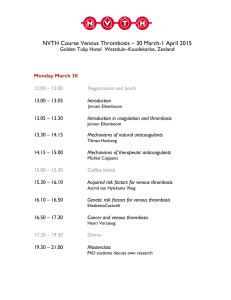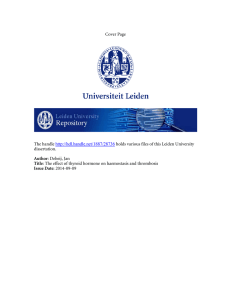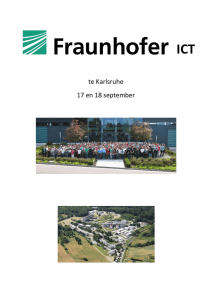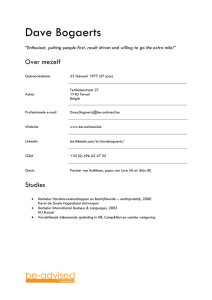Verstandige keuzes bij de interne geneeskunde
advertisement
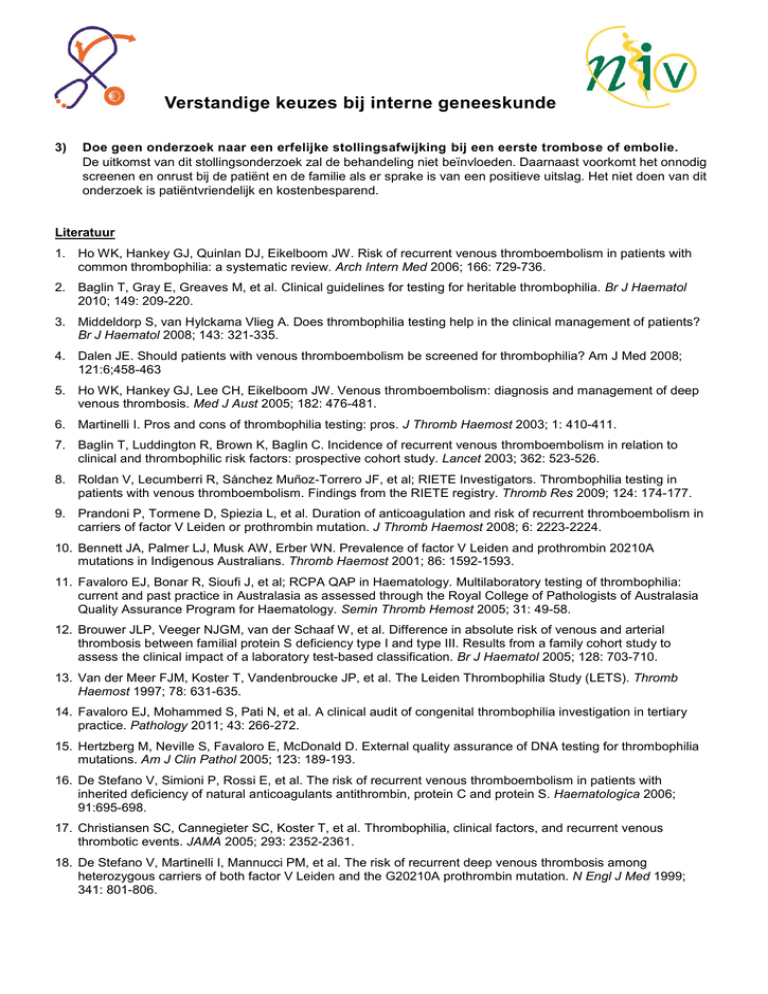
Verstandige keuzes bij interne geneeskunde 3) Doe geen onderzoek naar een erfelijke stollingsafwijking bij een eerste trombose of embolie. De uitkomst van dit stollingsonderzoek zal de behandeling niet beïnvloeden. Daarnaast voorkomt het onnodig screenen en onrust bij de patiënt en de familie als er sprake is van een positieve uitslag. Het niet doen van dit onderzoek is patiëntvriendelijk en kostenbesparend. Literatuur 1. Ho WK, Hankey GJ, Quinlan DJ, Eikelboom JW. Risk of recurrent venous thromboembolism in patients with common thrombophilia: a systematic review. Arch Intern Med 2006; 166: 729-736. 2. Baglin T, Gray E, Greaves M, et al. Clinical guidelines for testing for heritable thrombophilia. Br J Haematol 2010; 149: 209-220. 3. Middeldorp S, van Hylckama Vlieg A. Does thrombophilia testing help in the clinical management of patients? Br J Haematol 2008; 143: 321-335. 4. Dalen JE. Should patients with venous thromboembolism be screened for thrombophilia? Am J Med 2008; 121:6;458-463 5. Ho WK, Hankey GJ, Lee CH, Eikelboom JW. Venous thromboembolism: diagnosis and management of deep venous thrombosis. Med J Aust 2005; 182: 476-481. 6. Martinelli I. Pros and cons of thrombophilia testing: pros. J Thromb Haemost 2003; 1: 410-411. 7. Baglin T, Luddington R, Brown K, Baglin C. Incidence of recurrent venous thromboembolism in relation to clinical and thrombophilic risk factors: prospective cohort study. Lancet 2003; 362: 523-526. 8. Roldan V, Lecumberri R, Sánchez Muñoz-Torrero JF, et al; RIETE Investigators. Thrombophilia testing in patients with venous thromboembolism. Findings from the RIETE registry. Thromb Res 2009; 124: 174-177. 9. Prandoni P, Tormene D, Spiezia L, et al. Duration of anticoagulation and risk of recurrent thromboembolism in carriers of factor V Leiden or prothrombin mutation. J Thromb Haemost 2008; 6: 2223-2224. 10. Bennett JA, Palmer LJ, Musk AW, Erber WN. Prevalence of factor V Leiden and prothrombin 20210A mutations in Indigenous Australians. Thromb Haemost 2001; 86: 1592-1593. 11. Favaloro EJ, Bonar R, Sioufi J, et al; RCPA QAP in Haematology. Multilaboratory testing of thrombophilia: current and past practice in Australasia as assessed through the Royal College of Pathologists of Australasia Quality Assurance Program for Haematology. Semin Thromb Hemost 2005; 31: 49-58. 12. Brouwer JLP, Veeger NJGM, van der Schaaf W, et al. Difference in absolute risk of venous and arterial thrombosis between familial protein S deficiency type I and type III. Results from a family cohort study to assess the clinical impact of a laboratory test-based classification. Br J Haematol 2005; 128: 703-710. 13. Van der Meer FJM, Koster T, Vandenbroucke JP, et al. The Leiden Thrombophilia Study (LETS). Thromb Haemost 1997; 78: 631-635. 14. Favaloro EJ, Mohammed S, Pati N, et al. A clinical audit of congenital thrombophilia investigation in tertiary practice. Pathology 2011; 43: 266-272. 15. Hertzberg M, Neville S, Favaloro E, McDonald D. External quality assurance of DNA testing for thrombophilia mutations. Am J Clin Pathol 2005; 123: 189-193. 16. De Stefano V, Simioni P, Rossi E, et al. The risk of recurrent venous thromboembolism in patients with inherited deficiency of natural anticoagulants antithrombin, protein C and protein S. Haematologica 2006; 91:695-698. 17. Christiansen SC, Cannegieter SC, Koster T, et al. Thrombophilia, clinical factors, and recurrent venous thrombotic events. JAMA 2005; 293: 2352-2361. 18. De Stefano V, Martinelli I, Mannucci PM, et al. The risk of recurrent deep venous thrombosis among heterozygous carriers of both factor V Leiden and the G20210A prothrombin mutation. N Engl J Med 1999; 341: 801-806. Verstandige keuzes bij interne geneeskunde 19. Lijfering WM, Middeldorp S, Veeger NJGM, et al. Risk of recurrent venous thrombosis in homozygous carriers and double heterozygous carriers of factor V Leiden and prothrombin G20210A. Circulation 2010;121: 17061712. 20. Cohn D, Vansenne F, de Borgie C, Middeldorp S. Thrombophilia testing for prevention of recurrent venous thromboembolism. Cochrane Database Syst Rev 2009; (1) CD007069. doi: 10.1002/14651858. 21. Coppens M, Reijnders JH, Middeldorp S, et al. Testing for inherited thrombophilia does not reduce the recurrence of venous thrombosis. J Thromb Haemost 2008; 6: 1474-1477. 22. Santamaria MG, Agnelli G, Taliani MR, et al; Warfarin Optimal Duration Italian Trial (WODIT) Investigators. Thrombophilic abnormalities and recurrence of venous thromboembolism in patients treated with standardized anticoagulant treatment. Thromb Res 2005; 116: 301-306. 23. Schulman S, Lindmarker P. Thrombophilic polymorphism — a short-term or long-term risk for recurrence? J Thromb Haemost 2008; 6: 2225-2226. 24. Coppens M, van Mourik JA, Eckman CM, et al. Current practice of testing for inherited thrombophilia. J Thromb Haemost 2007; 5: 1979-1981. 25. Bates SM, Greer IA, Pabinger I, et al. Venous thromboembolism, thrombophilia, antithrombotic therapy, and pregnancy: American College of Chest Physicians Evidence-Based Clinical Practice Guidelines (8th Edition). Chest 2008; 133 (6 Suppl): 844S-886S. 26. Rodgers GM. Role of antithrombin concentrate in treatment of hereditary antithrombin deficiency. An update. Thromb Haemost 2009; 101:806-812. 27. Smith KJ, Monsef BS, Ragni MV. Should female relatives of factor V Leiden carriers be screened prior to oral contraceptive use? A costeffectiveness analysis. Thromb Haemost 2008; 100: 447-452. 28. Nicolaides AN, Breddin HK, Carpentier P, et al; European Genetics Foundation; Cardiovascular Disease Educational and Research Trust; International Union of Angiology; Mediterranean League on Thromboembolism. Thrombophilia and venous thromboembolism. International consensus statement. Guidelines according to scientific evidence. Int Angiol 2005; 24: 1-26. 29. Schulman S, Tengborn L. Treatment of venous thromboembolism in patients with congenital deficiency of antithrombin III. Thromb Haemost 1992; 68: 634-636. 30. Pernod G, Biron-Andreani C, Morange PE, et al; French group on haemostasis and thrombosis; French Society of Vascular Medicine. Recommendations on testing for thrombophilia in venous thromboembolic disease: a French consensus guideline. J Mal Vasc 2009; 34: 156-203. 31. Australian Government. Medicare Australia Statistics. Medicare item reports. https://www.medicareaustralia.gov.au/statistics/mbs_item.shtml (accessed Aug 2010). 32. Siragusa S, Caramazza D, Malato A. How should we determine length of anticoagulation after proximal deep vein thrombosis of the lower limbs? Br J Haematol 2009; 144: 832-837. 33. Kearon C, Kahn SR, Agnelli G, et al. Antithrombotic therapy for venous thromboembolic disease: American College of Chest Physicians Evidence-Based Clinical Practice Guidelines (8th Edition). Chest 2008; 133 (6 Suppl): 454S-545S. 34. Schulman S, Granqvist S, Holmström M, et al. The duration of oral anticoagulant therapy after a second episode of venous thromboembolism. The Duration of Anticoagulation Trial Study Group. N Engl J Med 1997; 336: 393-398. 35. Van Cott EM, Laposata M, Prins MH. Laboratory evaluation of hypercoagulability with venous or arterial thrombosis. Arch Pathol Lab Med 2002; 126: 1281-1295.
